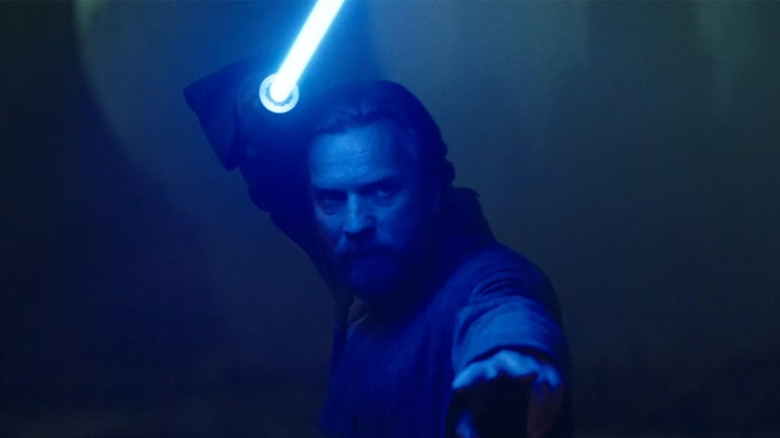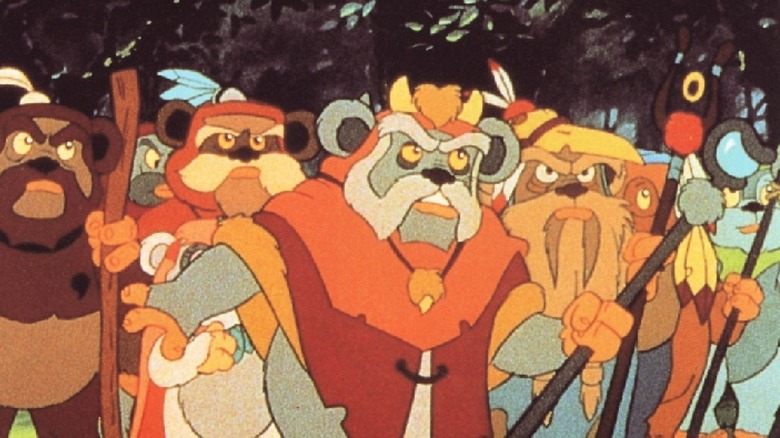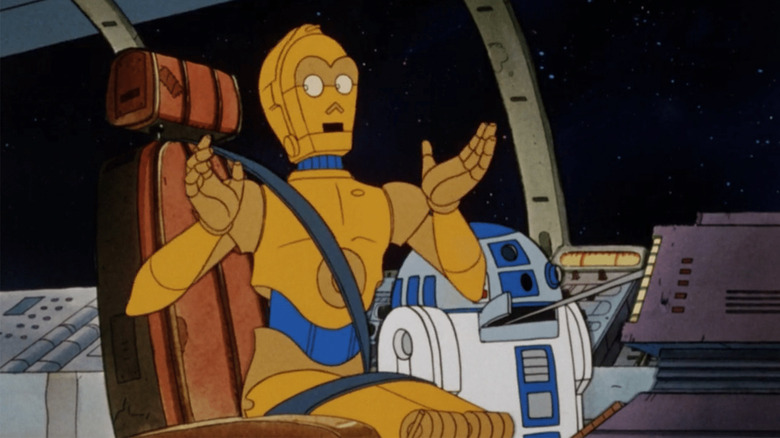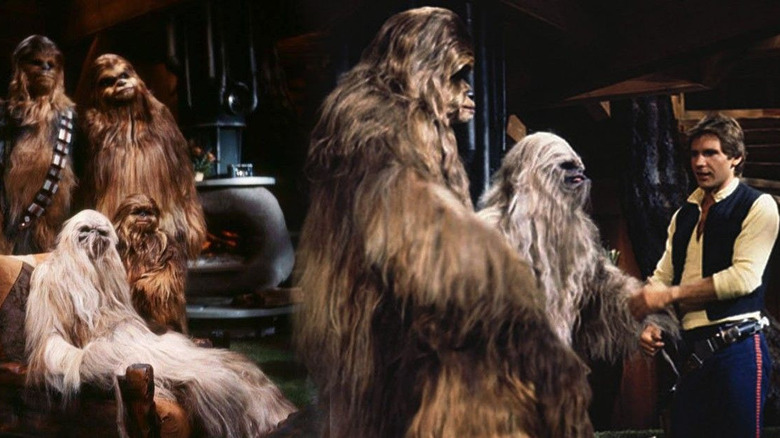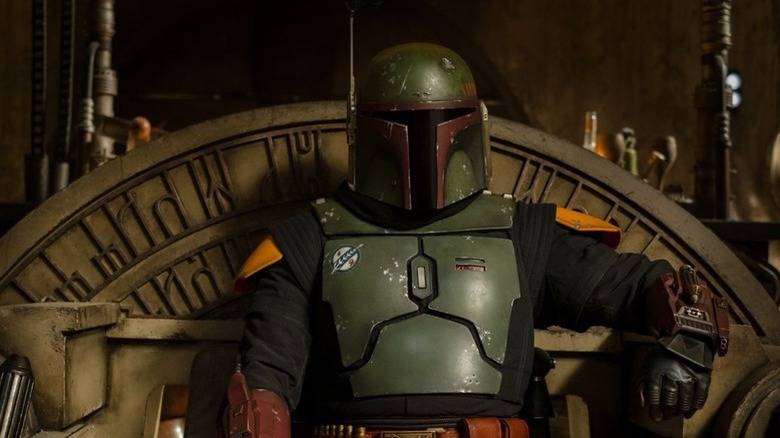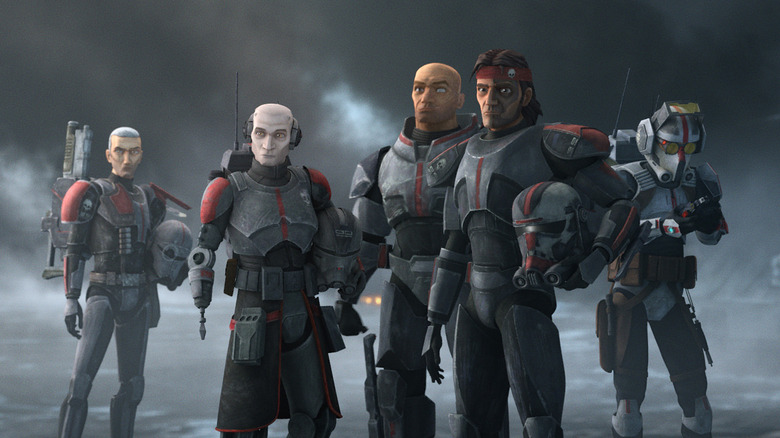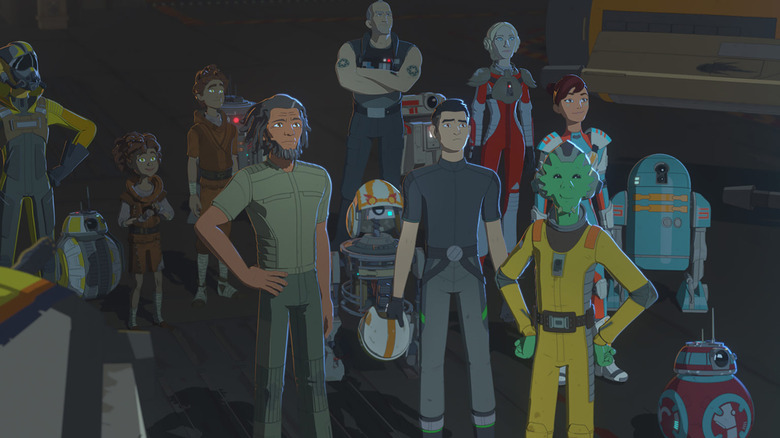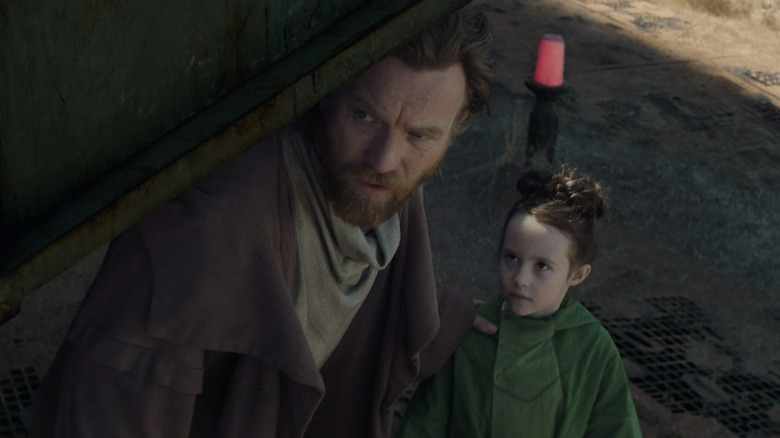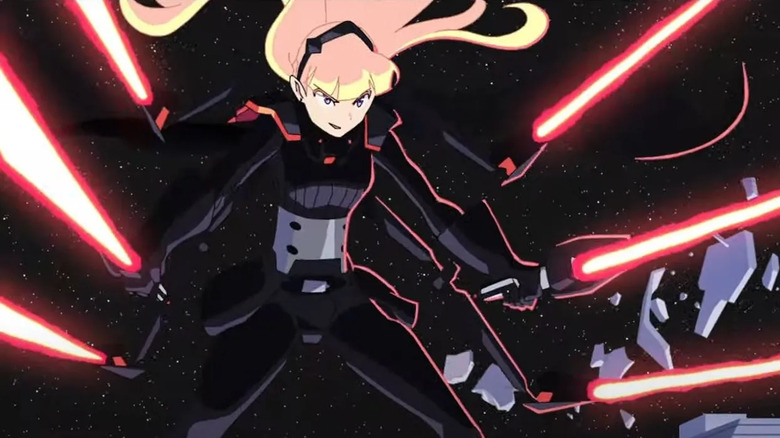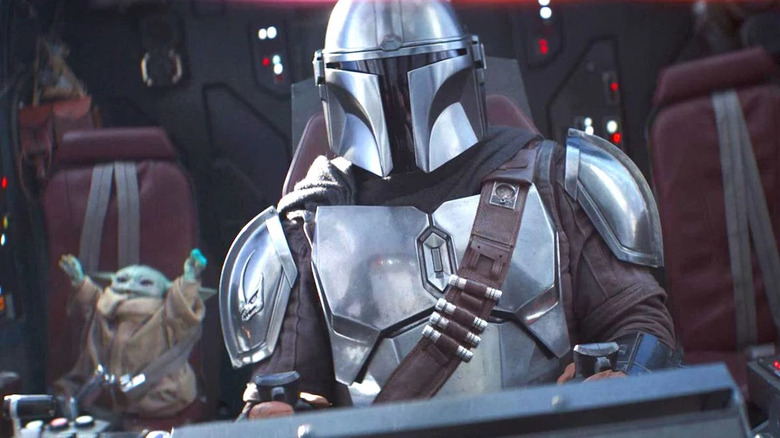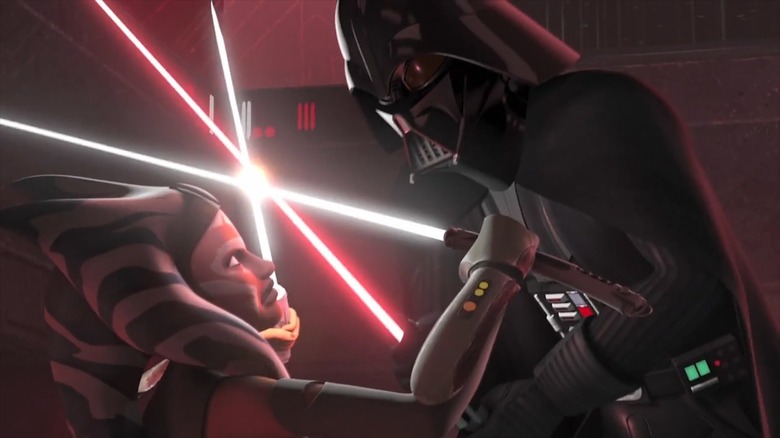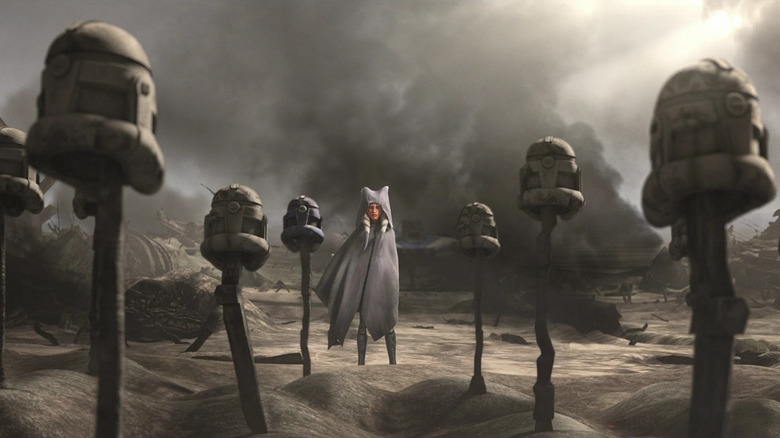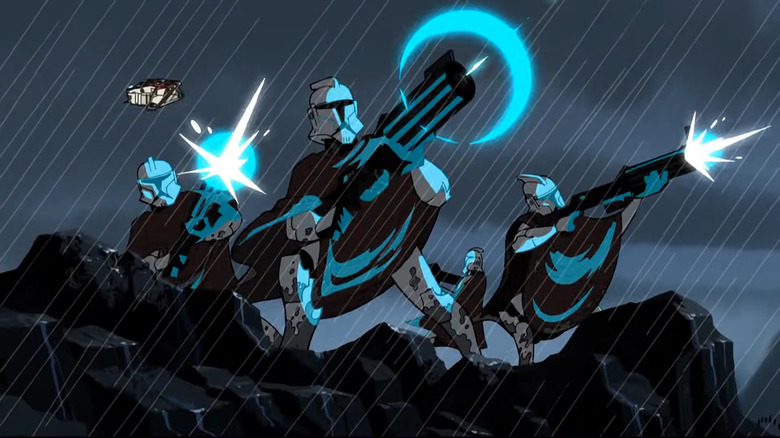Every Star Wars TV Series, Ranked
We've had 45 years of "Star Wars" stories told through every medium imaginable: movies, books, comics, video games, and even radio dramas. While the movies obviously get all the attention, the franchise is at its best when it's free to explore the implications and possibilities of its vast universe, which is why "Star Wars" feels at home on the small screen.
Sure, there have been misfires big and small, both from the past and present of "Star Wars" on TV, but there have also been some masterpieces with a huge impact on the franchise at large. Now that the theatrical films are waiting in the wings, the future of "Star Wars" is apparently on TV, and it's about time we ranked every single "Star Wars" TV show so far. No matter the quality, these are all a key part of the saga, and for better or for worse, that is what makes "Star Wars" endure. So let's dig into a galaxy far, far away on TV.
Disclaimer: We have not included any of the "LEGO Star Wars" animated specials, mostly because they fall so far outside of the traditional "Star Wars" framework that it didn't seem fair to rank them among everything else.
12. Ewoks
Though it boasts some great talent including "Batman: The Animated Series" creator Paul Dini as co-creator, "Ewoks" never really managed to get past its cheap Saturday morning cartoon "Smurfs but Ewoks" premise. A show clearly meant to sell merchandise and cute toys, there is rather little in the show that ties in, let alone improves upon, the overall "Star Wars" franchise. Sure, the finale kind of ties into "Return of the Jedi" in some cool ways, but it's not enough to justify the rest of the show.
11. Droids
"Droids" is an improvement upon "Ewoks," but that's not saying much. Developed by sound design maestro Ben Burtt, "Droids" had Anthony Daniels reprise his role as C-3P0 and it followed him and R2-D2 as they travel the galaxy and got in all sorts of troubles leading up to the events of "A New Hope." The cartoon showcased the underworld of "Star Wars" in a way we are only just now exploring again with shows on Disney+, with the droids facing off against pirates and criminals, in addition to the threat of the Empire.
Sadly, it was still very much a Saturday morning cartoon, and its limited budget and cheap animation prevented the show from being truly great.
10. The Star Wars Holiday Special
The most infamous piece of "Star Wars" media, "The Star Wars Holiday Special" is a variety-show type special revolving around a Wookie holiday known as Life Day. There are appearances from most of the main cast, bizarre musical numbers, Bea Arthur at a cantina, and excessive use of eyeliner. Sadly, the result was atrocious, to the point where Lucas and most of the people involved completely disowned the special, and today the only portion of it you can legally find anywhere is an animated segment that introduced the world to Boba Fett. Still, it is a deeply weird and sarcastically beloved piece of "Star Wars" history.
9. The Book of Boba Fett
For a show called "The Book of Boba Fett," it's rather problematic that the best parts of the show don't really involve its titular character at all. The second live-action "Star Wars" show has plenty going for it — Temuera Morrison being a badass, Machete in space, Boba riding a Rancor — but its best parts, namely the return of Din Djarin and Grogu, take away from Boba's story.
The problem is that "The Book of Boba Fett" never quite comes together in a cohesive way. As expensive and cool as the show looks, the story of Boba Fett becoming a benevolent crime boss never resonated with audiences, resulting in a mixed bag.
8. The Bad Batch
"The Bad Batch" debuted with a phenomenal 70-minute premiere that featured some of the finest "Star Wars" animation yet, with lighting and camera work surpassing even some of the live-action movies, not to mention featuring kickass action. But after its impressive premiere, the show's individual episodes failed to capture that initial excitement. Still, there is plenty to love in this show, from its character dynamics to the horrors of the early days of the Empire, and Omega is one of the best new "Star Wars" characters in years. Special props should go to voice actor Dee Bradley Baker, who never ceases to amaze with his ability to give each and every clone a unique personality and voice, making the members of the titular Bad Batch feel lived-in.
7. Star Wars Resistance
"Star Wars Resistance" is a bit of a dark horse when it comes to "Star Wars" animation. The show is the only one set in the time of the sequel trilogy, allowing for cameos from characters like Poe Dameron and Kylo Ren, and it centers on a hopeful ace pilot who infiltrates the First Order to gather intelligence for the Resistance. Pretty basic "Star Wars" stuff, but it's the animation where this series is unique.
The show features a more anime-inspired cel-shading art style that instantly makes it stand out from the rest of the animated fare in the franchise, but it was met with a wave of criticism that basically amounted to, "This is for kids!" However, "Resistance" doesn't shy away from heavier subjects and themes. Add a focus on non-Force users, a diverse cast of characters, and satisfying long-term story arcs, including an indoctrination subplot, make for a fascinating addition to "Star Wars" lore.
6. Obi-Wan Kenobi
Ewan McGregor and Hayden Christensen made their triumphant return to the galaxy far, far away with "Obi-Wan Kenobi." While it could have benefitted from a shorter movie-like runtime, the show is a wonderful gift for fans of the prequel trilogy. Exploring the darkest period in the history of "Star Wars," we get a beaten, guilt-ridden Kenobi reluctantly coming out of hiding, Darth Vader at the height of his powers, and an epic rematch between master an apprentice. Plus, we get a young Leia story, something we should have gotten years ago.
The show offers plenty of callbacks and references to the prequel trilogy, but also emotional payoffs to years-old storylines, many of which we only truly saw in animation. It even enhances aspects of the original trilogy. Is "Kenobi" perfect? Hell no, but it's a thrilling, compelling new chapter with just the right amount of nostalgia for a part of the franchise that never got the love it deserved.
5. Visions
What do you get when you combine the endless possibilities of "Star Wars" and a group of the greatest minds in the anime industry with free reign to do whatever they want? One of the best "Star Wars" experiences in years.
"Visions" is an anime-style anthology show that is mostly non-canon, with stories set in wildly different parts of the "Star Wars" universe (featuring a variety of anime aesthetics) from the far past to the far future. There are plenty of unique and inventive takes on the Jedi, the Force, and the entire galaxy, from a little robot that can use the Force to a rockin' musical featuring Jabba the Hutt. And let's not forget about the Jedi ronin and a kid slicing through an entire Star Destroyer with his lightsaber. You've never seen "Star Wars" like this before, and it rules.
Of course, this being an anthology, not every episode is a winner, but the show overall still offers a window into a bright future where "Star Wars" is imaginative again, where all sorts of stories that don't all look and feel the same can co-exist. It's a show that truly understands the promise of the galaxy far, far away.
4. The Mandalorian
No one predicted that the first live-action "Star Wars" show would become the cultural phenomenon that was "The Mandalorian." Granted, the pop culture dominance of the series can largely be attributed to Baby Yoda, the single best new character in all of "Star Wars" since diner owner Dexter Jettster, and for good reason. Grogu became an instant success as soon as he debuted, and before we got inundated with "Lone Wolf and Cub" stories on TV, the relationship between Mando and Grogu was emotional, touching, and even heartbreaking at times. But even outside of the money-printing merchandise machine, this show has a lot more to offer.
The first season of "The Mandalorian" felt fresh and exciting the way no "Star Wars" project had felt in years, moving the focus away from the Jedi and shining a light on a different part of the world than we had seen in the films. With an episodic format and a western feel to the show, "The Mandalorian" brought back the serial influences that are at the core of the franchise's DNA. "The Mandalorian" is so good that it kept "The Book of Boba Fett" from being a complete waste of time.
3. Star Wars Rebels
The first "Star Wars" show after the Disney acquisition of Lucasfilm, "Star Wars Rebels" had a lot to live up to, especially following the unceremonious cancellation of "The Clone Wars." But "Rebels" not only managed to surpass expectations, it quickly became one of the best "Star Wars" stories ever. The show explores the dark years of the Rebellion pre-"Rogue One," and it is a true joy seeing this grassroots operation grow into a force that would later change the galaxy.
With a fantastic cast of likable and memorable characters, "Rebels" succeeded at telling a brand new story while also bringing in familiar faces to use effectively. Did we need Darth Vader or the return of Darth Maul? Maybe not, but seeing Vader face off against Ahsoka or Maul get his last duel against Obi-Wan brought thematic resonance and a perfect end to their storylines.
Creator Dave Filoni brings in a unique understanding of "Star Wars" to the show, adding to the lore in mysterious and fascinating ways (time travel! intergalactic whales!), while also bringing back to the canon one of the most cherished villains in the franchise: Grand Admiral Thrawn. The show may have gotten off to a rocky start, but by the time the finale ends, it's hard not to be engrossed with this world and lament its ending.
2. The Clone Wars
Dave Filoni's "The Clone Wars" played an integral role in the reclamation of the prequel trilogy, fleshing out characters like Obi-Wan and Anakin even more while also giving a proper spotlight to Padmé, Bail Organa, many other Jedi, and even the titular clone army.
"The Clone Wars" manages to make the faceless CGI clone army of the movies feel like actual individuals with distinct personalities and stories. We watched as these clones fought for their individuality, became friends, grieved the loss of their brothers, questioned orders and their reason to exist, and yet they still found meaning in their work. Despite being a show aimed at all audiences, "The Clone Wars" never shied away from accurately portraying the conflict that gave it its title. We see how war profiteering spreads throughout the galaxy, meet children orphaned by battle, observe how criminals thrive under conflict, and also get a glimpse at the sparks of rebellion lit up across the galaxy.
"The Clone Wars" made a whole generation fall in love with Anakin in a way none of the films never even remotely got close to, turning the whiny teenager into a loyal, skilled, funny, multi-dimensional character struggling to keep his emotions at bay, providing key context to his turn to the dark side. Likewise, the show's re-introduction of Darth Maul gave the character justice and turned him into a delightfully evil and, at times, even tragic figure.
Arguably, the biggest contribution "The Clone Wars" gave the overall franchise is the introduction of Anakin's padawan, Ahsoka Tano. The character quickly became one of the most popular characters in the franchise, helped humanize the Jedi Knight, and became an integral part of "Star Wars" mythology.
1. Genndy Tartakovsky's Clone Wars
Before it got brutally and unceremoniously de-canonized by Disney, Genndy Tartakovsky's "Clone Wars" micro-series busted the doors wide open to reveal the possibility for "Star Wars" to become more than just a film franchise. Originally meant to be little more than a teaser for "Revenge of the Sith," giving us a glimpse of the war that the movies were too busy to actually explore, "Clone Wars" remains the most creative, visually stunning, and totally bonkers "Star Wars" TV show, even 20 years after its debut.
The micro-series showed the Jedi not as warriors or flawed characters, but as myths, or even gods of legend. Tartakovsky uses animation to show the space warrior monks doing incredible gravity-defying feats, such as Anakin fighting Asajj Ventress almost at the speed of light or Mace Windu destroying an entire battalion of battle droids with nothing but his fists. Tartakovsky is a master of animated rhythm, and the show gives us action scenes with rhythmic timing that would make Edgar Wright blush, all with shockingly little dialogue.
"Clone Wars" also gave us three of the coolest villains in the franchise's history — Asajj Ventress, General Grievous (pre-asthma!) and also Durge, the unkillable bounty hunter. Before Vader became a fearsome villain once again during the hallway scene of "Rogue One," Tartakovsky's "Clone Wars" gave us a psychopathic cyborg killer that obliterated any Jedi he came across, and an unkillable bounty hunter whose body morphed like Tetsuo in "Akira."
Every "Star Wars" TV show has pushed the idea of what the franchise can be to new places, but none have used the medium of television to show something as unique to the format as "Clone Wars." With its micro-episode length, stylish animation and singular sense of action and rhythm, Tartakovsky showed that the galaxy far, far away could also be right in your living room, and he made it look extremely cool at the same time.
